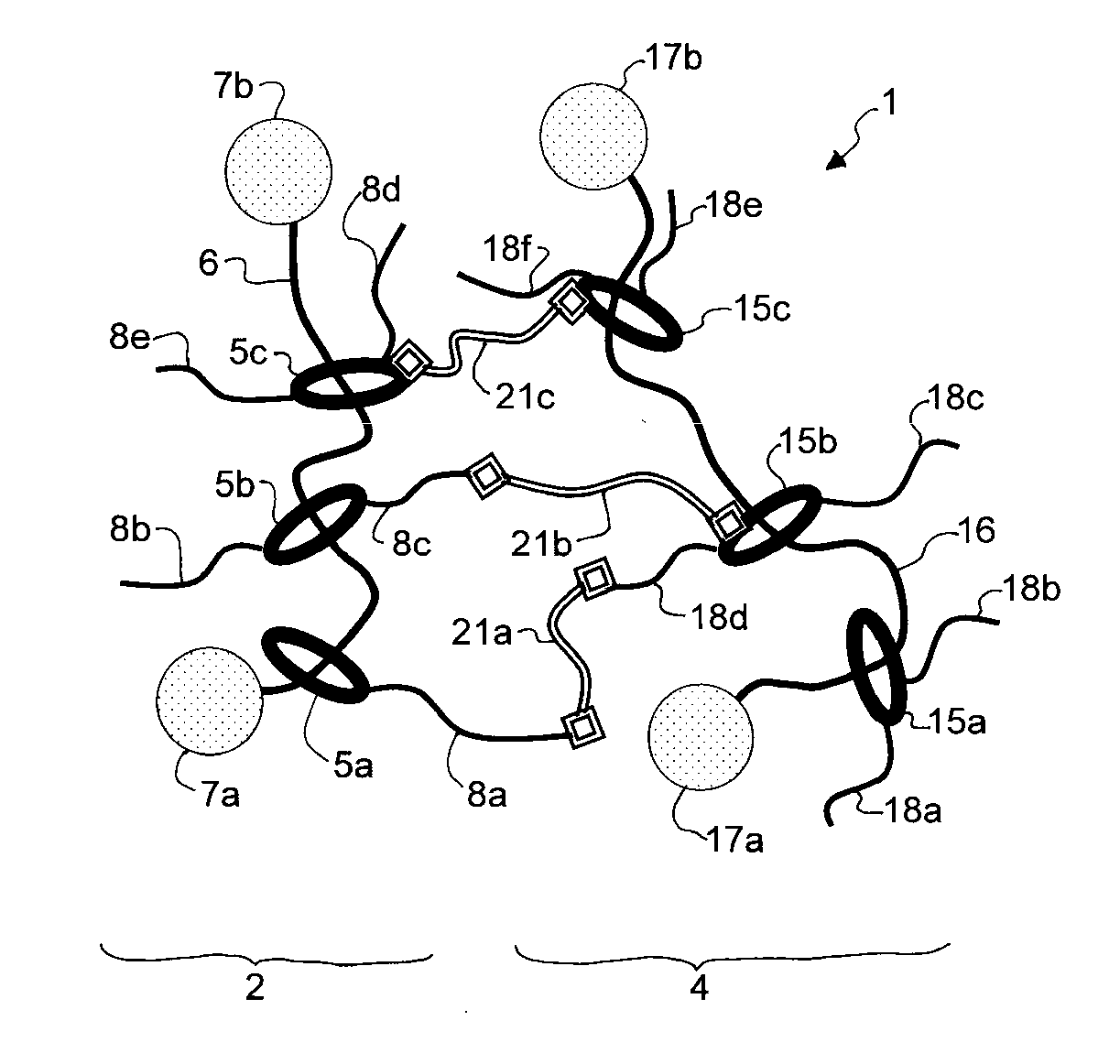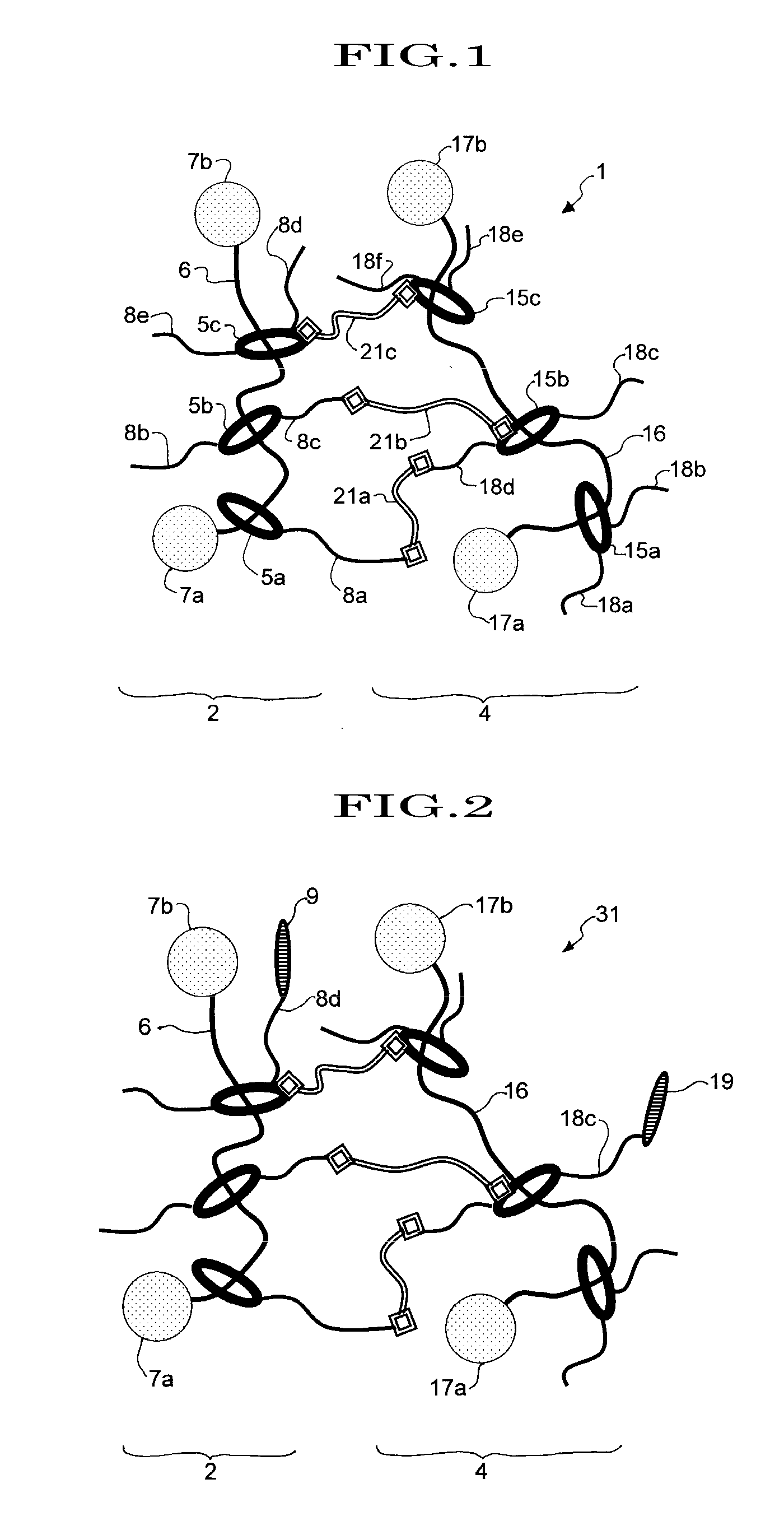Material having cross-linked polyrotaxane, and method for producing same
- Summary
- Abstract
- Description
- Claims
- Application Information
AI Technical Summary
Benefits of technology
Problems solved by technology
Method used
Image
Examples
synthetic example a-1
Preparation of a Crosslinking Agent A-1
[0171]A solution, in which 7 g of tolylene-2,4-diisocyanate (Tokyo Chemical Industry, Co., Ltd.) was dissolved in 30 ml of dehydrated toluene under a nitrogen atmosphere, was vigorously stirred at 80° C. Into the solution, a solution of 30 g of both ends diol terminated polypropylene glycol (Mn=3000, Polymerization degree: 50-52, Wako Pure Chemical Industries, Ltd.) dissolved in 60 ml of dehydrated toluene was added dropwise, and stirred for 2 hours. After the reaction, the solvent was removed in vacuo, to obtain a crosslinking agent A-1 comprising polypropylene glycol, both ends of which are modified with isocyanate groups.
synthetic example a-2
Preparation of a Crosslinking Agent A-2
[0172]A solution, in which 7g of tolylene-2,4-diisocyanate (Tokyo Chemical Industry, Co., Ltd.) was dissolved in 30 ml of dehydrated toluene under a nitrogen atmosphere, was vigorously stirred at 80° C. Into the solution, a solution of 20g of polypropylene glycol monobutyl ether (Mn=2500, Polymerization degree: 40-42, Aldrich) dissolved in 50 ml of dehydrated toluene was added dropwise, and stirred for 2 hours. Into the solution, a solution of 30g of both ends diol terminated polypropylene glycol (Mn=3000, Polymerization degree: 50-52, Wako Pure Chemical Industries, Ltd.) dissolved in 50 ml of dehydrated toluene was added dropwise, and stirred for more 2 hours. After the reaction, the solvent was removed in vacuo, to obtain a crosslinking agent A-2 comprising polypropylene glycol, both ends of which are modified with isocyanate groups and polypropylene glycol monobutyl ether, one end of which is modified with isocyanate group.
synthetic example a-3
Preparation of a Crosslinking Agent A-3
[0173]A solution, in which 10g of tolylene-2,4-diisocyanate terminated polypropylene glycol (Mn=2300, Polymerization degree: 33-36, Aldrich) was dissolved in dehydrated toluene (10 ml) under a nitrogen atmosphere, was vigorously stirred at 80° C. Into the solution, a solution of 4.35 g of both ends diol terminated polypropylene glycol (Mn=3000, Polymerization degree: 50-52, Wako Pure Chemical Industries, Ltd.) dissolved in 30 ml of dehydrated toluene was added dropwise, and stirred for 5 hours. After the reaction, the solvent was removed in vacuo, to obtain a crosslinking agent A-3 comprising polypropylene glycol, both ends of which are modified with isocyanate groups (Mn=7600, Polymerization degree: 83-88).
PUM
| Property | Measurement | Unit |
|---|---|---|
| Pressure | aaaaa | aaaaa |
| Frequency | aaaaa | aaaaa |
| Fraction | aaaaa | aaaaa |
Abstract
Description
Claims
Application Information
 Login to View More
Login to View More - R&D
- Intellectual Property
- Life Sciences
- Materials
- Tech Scout
- Unparalleled Data Quality
- Higher Quality Content
- 60% Fewer Hallucinations
Browse by: Latest US Patents, China's latest patents, Technical Efficacy Thesaurus, Application Domain, Technology Topic, Popular Technical Reports.
© 2025 PatSnap. All rights reserved.Legal|Privacy policy|Modern Slavery Act Transparency Statement|Sitemap|About US| Contact US: help@patsnap.com


